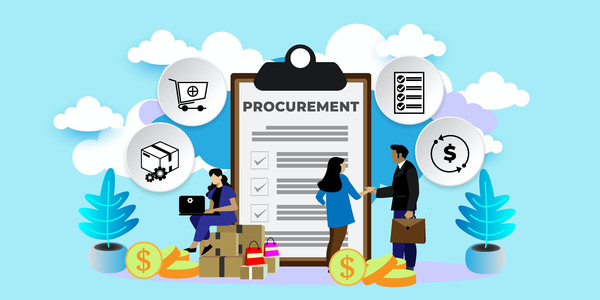
All businesses rely heavily on their supply chain function to meet their strategic objectives. One of those essential supply chain functions is procurement.
Procurement is a decision-based set of processes that includes sourcing suppliers, negotiating, agreeing contracts, tendering, and placing purchase orders.
The procurement cycle can help a business understand the steps in which products, materials, and services are acquired.
In this article, we will be looking at the procurement cycle; we’ll discuss:
- What is the procurement cycle?
- What are the steps of the procurement cycle?
- What is a public procurement cycle
- Procurement Cycle effectiveness
- What are the benefits of the procurement cycle?
- Common issues with the procurement cycle?
What is the procurement cycle?
The procurement cycle:
- Is a model that describes, by a series of high-level steps, an organization’s procurement process.
- Is a key strategic process.
- Describes how materials and services are bought into an organization.
- Establishes the sequence in which process steps occur.
- Is often heavily influenced by the needs of the customer.
- Can be portrayed in varying levels of complexity
Below is an example of a procurement cycle
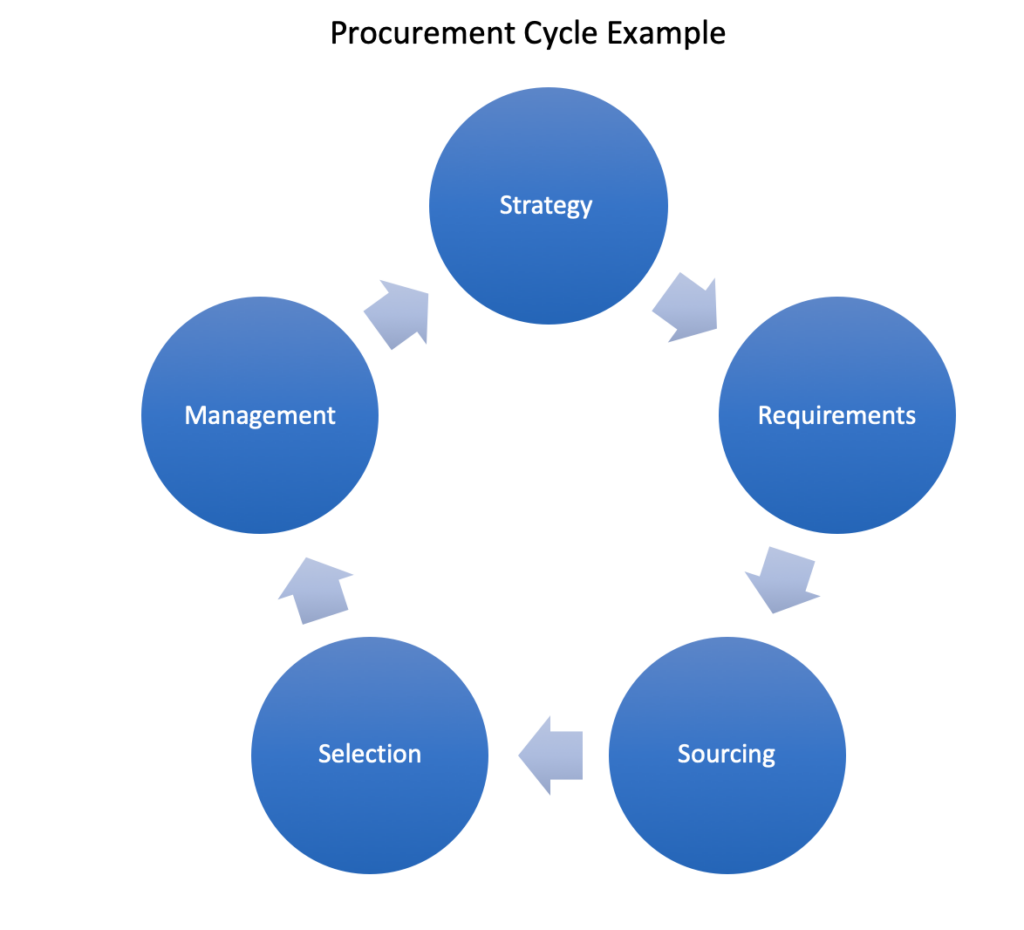
Viewing the procurement cycle can enable an organization to understand underlying procurement processes that can be complex with varying inputs and outputs.
The procurement cycle has several characteristics:
- It’s cyclical, representing a constant need for material and supplier management
- It’s defined by steps, each of which is critical to the overall process
- These steps usually feature a set of key principles that establish an effective process
- It’s adaptable
- It focuses on the total cost of the process rather than the price of the item
With a little research, you will see a number of procurement cycle models that vary in complexity and number of steps.
These cycles may vary from a relatively simple procurement cycle of 5 or 6 steps to other, more detailed examples showing a greater number of activities.
Those examples with larger numbers of steps often break down tasks into sub-tasks.
When developing your own procurement cycle, you’ll need to:
- Consider the impact on your own internal processes
- Consider the impact on your wider environment
- Consider the impact on your customer
In this article will cover several procurement cycle examples to demonstrate how they are structured and how you can apply the model to your business.
Remember, the key to the procurement cycle is providing a clear understanding of management processes.
A failure to manage cost or performance can drive serious issues.
Therefore, processes that establish a procurement function that drives cost-effectiveness, delivery performance, and vendor evaluation and selection have a key part to play.
What are the steps of the procurement cycle?
As we described above, there is a multitude of procurement cycles available in varying complexity; we’ll cover three examples below:
Simple procurement cycle
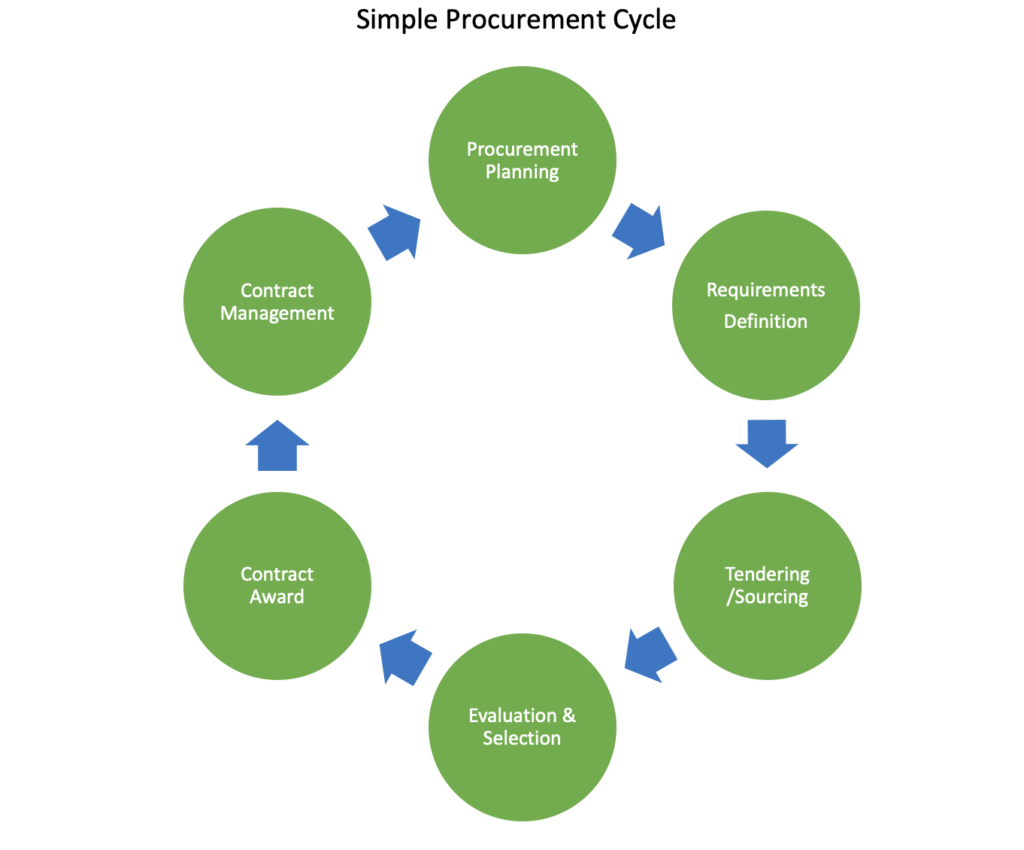
The basic six steps of a simple procurement cycle are:
1/ Procurement planning
This stage features:
- Identifying the business need or problem to be solved
- Identifying timing of requirement (when do we need it, how much, etc.)
- Identifying the possible procurement route(s) (i.e. lease/buy etc)
- Identifying potential suppliers
- Alignment to procurement strategy
2/ Requirement definition
Identifying the specifications of what is required to further finesse the supplier pool and ensure that you place contracts for what is needed.
This phase will usually include
- Identifying detailed specs (i.e Functional/Technical)
- Particular Terms & Conditions required (i.e. warranty etc)
- Identifying points of interest/information for potential suppliers
3/ Tendering or sourcing
This phase primarily deals with communicating requirements and receiving responses from suppliers. There may be technical reviews required (where suppliers have queries) or clarifications over commercial terms, so it should be seen as more than just a “transactional” phase.
Typical steps include:
- Issue Request for quotes or tender documents to supplier pool
- Receive response
4/ Evaluation and selection
Once the responses have been received, the buying organization will be required to sift through the responses, evaluate them, and down-select to a chosen supplier.
There is a wide range of tools and methods for evaluating responses, whether driven by cost, technical response, Lead time, or a combination.
5/ Contract award
Once you have selected a supplier, the next phase is to place a purchase order or contract; this will include:
- Communication with the supplier
- Award contract/ Place purchase order
6/ Contract management
Once the purchase order has been placed, the next phase is to manage the supplier to delivery. There may be further communications with the supplier (especially where problems emerge)
This phase will include:
- Manage contract through to delivery & closure
Complex procurement cycle
This more complex model has some further additional steps than our initial model.
There is still a key requirement to focus on need, specification, and sourcing, but this cycle expands on the concept of contract management, focusing in more detail around delivery and key processes required.
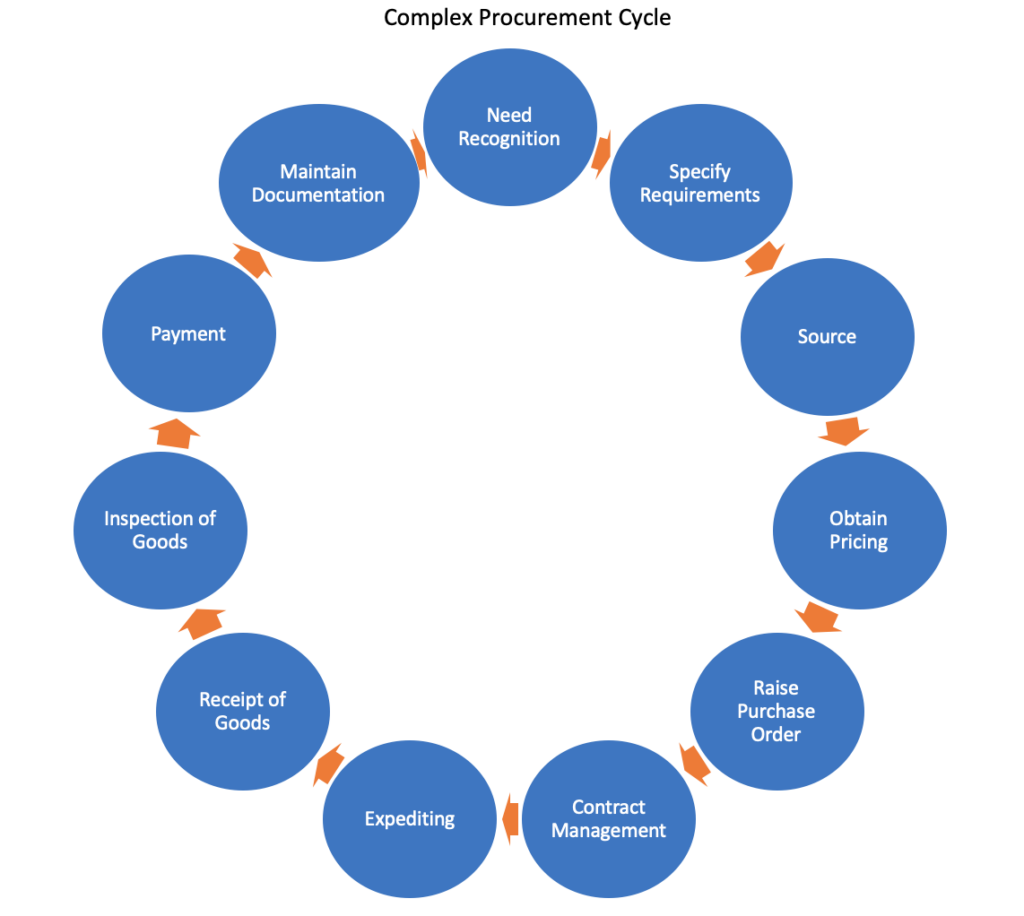
1/ Need recognition
- Identifying requirement
- Identifying schedule (when do we need it, how much, etc.)
- Identifying the procurement route (i.e. lease/buy)
- Identifying potential suppliers
- Alignment to procurement strategy
2/ Specify requirement
- Detailed requirements specification
3/ Source
- Identify possible suppliers
- Supplier evaluation
- Create an approved supplier list
4/ Obtain price and terms
- Request for Quotation / Tender
- Communication
- Receipt of offer
- Downselection
5/ Raise purchase order
- Raise Purchase Order / Contract
6/ Contract Management
- Management of the purchase order/contract with the supplier
7/ Expediting
- Control the progress of Manufacturing/Delivery
- Buyer / Supplier communication
- Manage and review delivery dates, updating appropriate IT systems
8/ Receipt of goods
- Management of the receipt of materials/Services into the buying business
9/ Inspection of goods
- Validation of goods/services received to ensure they meet the terms of the contract – typically focused on Quality Assurance (are the goods to the right standards – i.e., free from defects, supported by appropriate documentation, etc.).
10/ Payment
- Once goods have been qualified, payment is issued to the supplier within the agreed terms of the contract
11/ Maintain documentation
- Documentation supporting the buying activity is maintained and controlled (this invariably includes the initial requirements through to delivery documentation). This can either be physical or electronic documents.
CIPS procurement cycle
You can read about the CIPS procurement and supply cycle in detail here.
The CIPS cycle expands further on the complex procurement cycle and is a highly detailed and descriptive model which includes:
- Identification of policy and process requirements
- Sustainability and Environment considerations
- Consideration for innovation
- Focus on strategy & method
- Opportunity for gate reviews at the end of each step to ensure compliance
- Highlights modern issues affecting the supply chain
- Counterfeit Goods
- Procurement technology
If you’re looking at how to develop a robust, modern, and technically competent procurement cycle, I’d recommend that you investigate it.
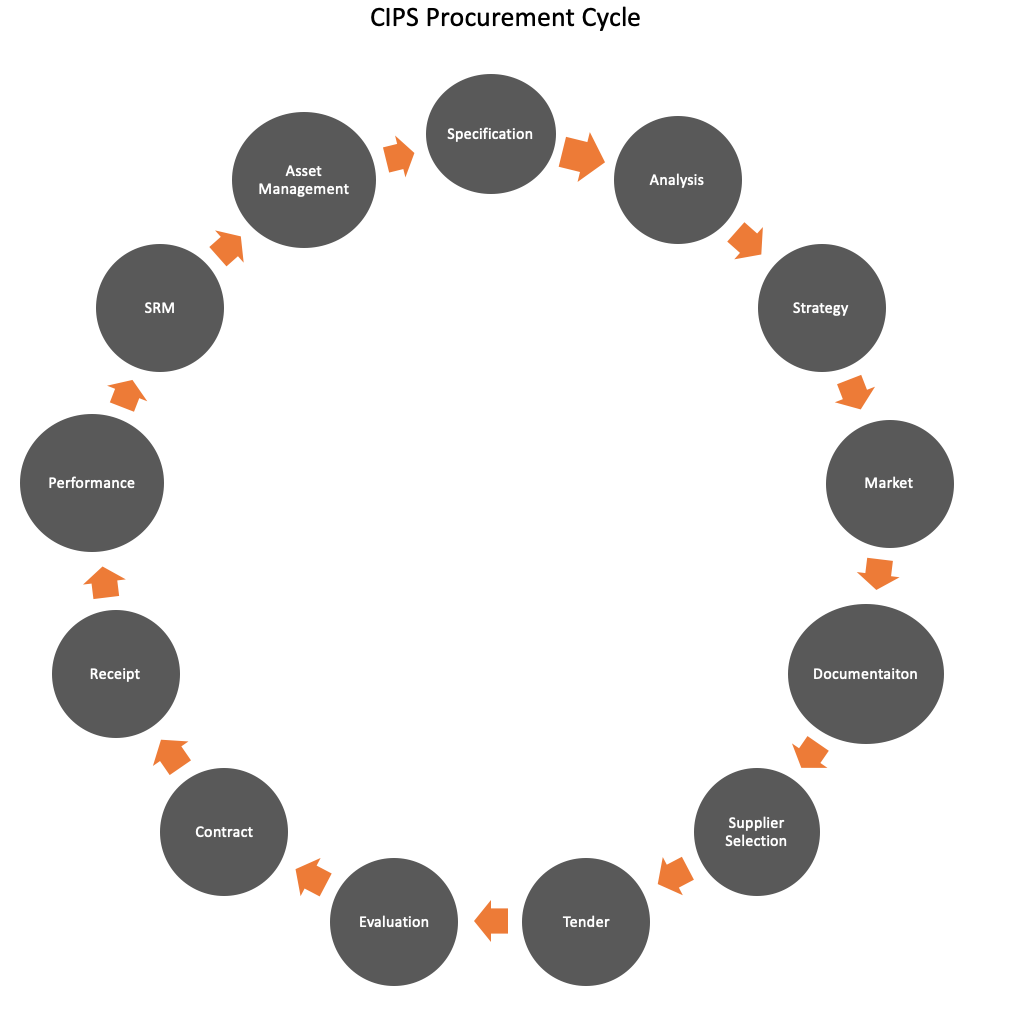
It has the following 13 steps.
1/ Specification
- Identify and define business need
2/ Analysis
- Review the market and identify opportunity
3/ Strategy
- Develop plans on how to meet the business need
4/ Market
- Identify stakeholder needs – review, adapt and align procurement strategy
5/ Documentation
- Develop tender documents
6/ Supplier selection for tender participation
- Conduct Request for Information, gain insight into suppliers
7/ Tender
- Issue tender documents request for quotation
8/ Evaluation
- Bid Evaluation against award criteria
- Down select to preferred supplier
9/ Contract
- Issue contract / Purchase Order
10/ Warehouse, Logistics, Receipt
- Manage warehouse activities through to receipt of goods
11/ Performance
- Measure contract performance against contract
12/ Supplier Relationship Management
- Developing & sustaining supplier relationships in order to meet business goals
13/ Asset Management
- Assess business requirements
- Validate supplier agreements
- Continuous improvement
What is a public procurement cycle?
The public procurement cycle has much in common with the examples we’ve discussed above.
Public procurement is the purchasing of materials, services with public funds, which in turn help contribute to the delivery of public services and or goods.
There is usually a significant focus on
- Value for money
- Meeting requirements
- Transparency of process
- Compliancy to process
It’s very common for public procurement to operate via a Tender > Bid > Down Select > Negotiation process, which is often facilitated by online tender management software.
The below offers a representation of a standard public procurement model.
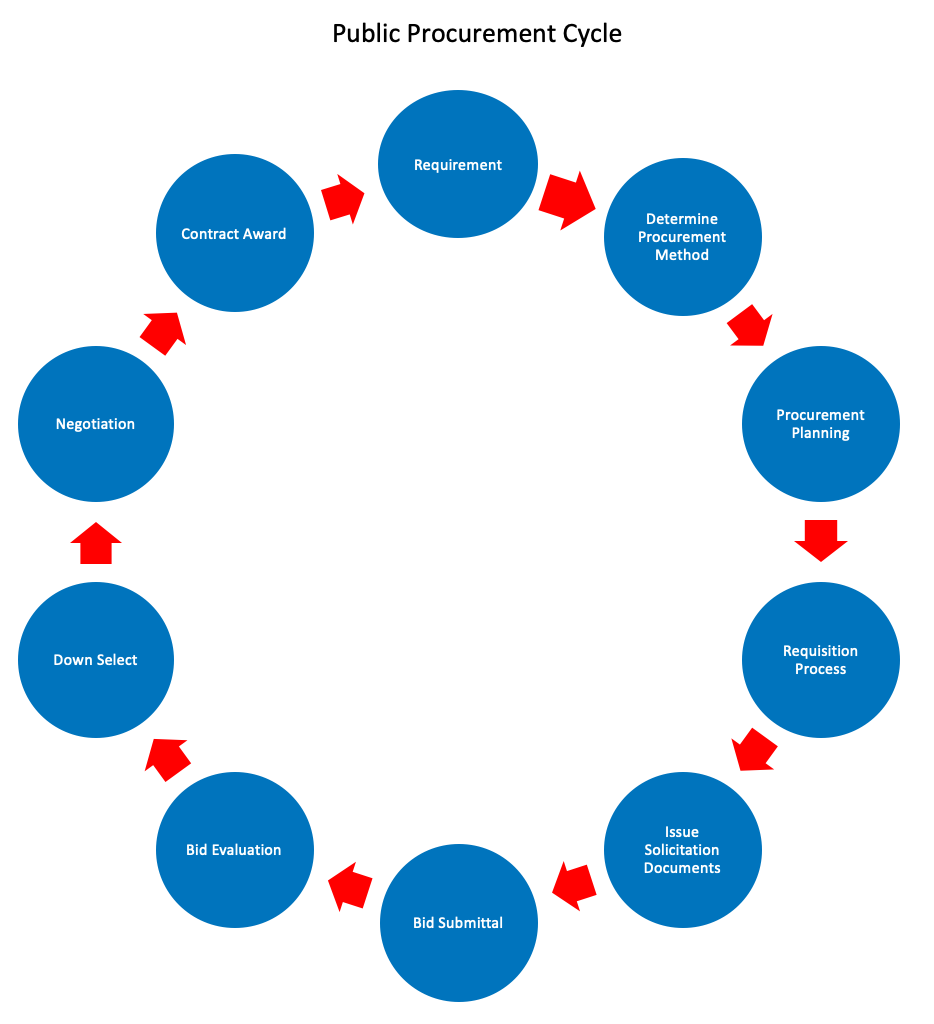
1. Identify requirement
- Identification of business need
2. Determine appropriate method of procurement
- Assess methods to be used e.g.
- Make/buy
- Buy / Lease
- Sole source / multi-source
- Batch buy/timed delivery.
3. Procurement planning
- Finalize method of procurement
- Identifying potential suppliers
- Alignment to procurement strategy
4. Requisition process
- Document requirements
- Formalize demand (i.e., Load requirements onto purchase system)
5. Prepare and issue Solicitation documents
- Document Request for information, Request for Quotation, Tender documents
7. Bid submittal
- Receive bids from suppliers
8. Bid evaluation
- Evaluate supplier responses
9. Down selection
- Selection of preferred bidder(s).
10. Negotiation
- Negotiate with preferred bidder(s)
11. Contract Award
- Issue Contract / Purchase Order
Procurement Cycle effectiveness
It’s not enough to merely have a procurement cycle that represents your organization’s procurement steps.
The nature of the model that it breaks your process down into steps provides you with a tool that can be used to:
- Benchmark specific parts of your process with others
- Identify weaknesses in the chain of processes
- Identify capability gaps
- Highlight areas of risk
Understanding your procurement cycle in depth can provide you with a start point to key continuous improvement activities that can improve performance.
What are the benefits of the procurement cycle?
There are several key benefits of using this model:
- It promotes a standard methodology
- Is adaptable to the needs of business
- Incorporates best practice into a logical process flow
- Each “step” may have a subset of processes
- Can be promoted within the supply base to provide a transparent view of the acquisition process (especially in public procurement)
- Maps a start point for continuous improvement
Common issues with the procurement cycle
Common issues include:
- While there are common models, no one size fits all, and each business is likely to need to adapt
- While there are indicative steps, the model does not describe complexity or entry-exit criteria for each step
- The procurement cycle is not a magic bullet, it is a methodology, and you will still need to put the work in to get value from it – it structures the process it does not do it for you!
- It can be overly simplistic
- Having a structure de-risks the task, but it doesn’t identify risks / potential issues within the process, you will still need to run appropriate risk identification and mitigation activities
- It doesn’t identify attributes that drive performance, merely the steps required
Summary
Clearly, procurement is a critical business enabler that firms require to be effective in order to meet goals.
The Procurement cycle offers a way of mapping out the key steps in the procurement process.
It is not a one size fits all model and can be adapted to cater to specific changes within each business that utilizes it.
What’s your experience with the procurement cycle? Have you looked to utilize it within your business? Perhaps you’ve looked to adapt it to specific business needs? Perhaps you have experience with the public procurement cycle?
As ever, we’d love feedback; you can reach us on Twitter or via the comments section below.
This article is part of our Supply Chain Guide.